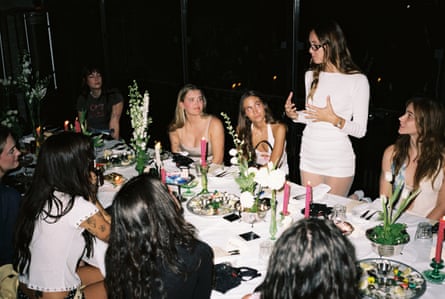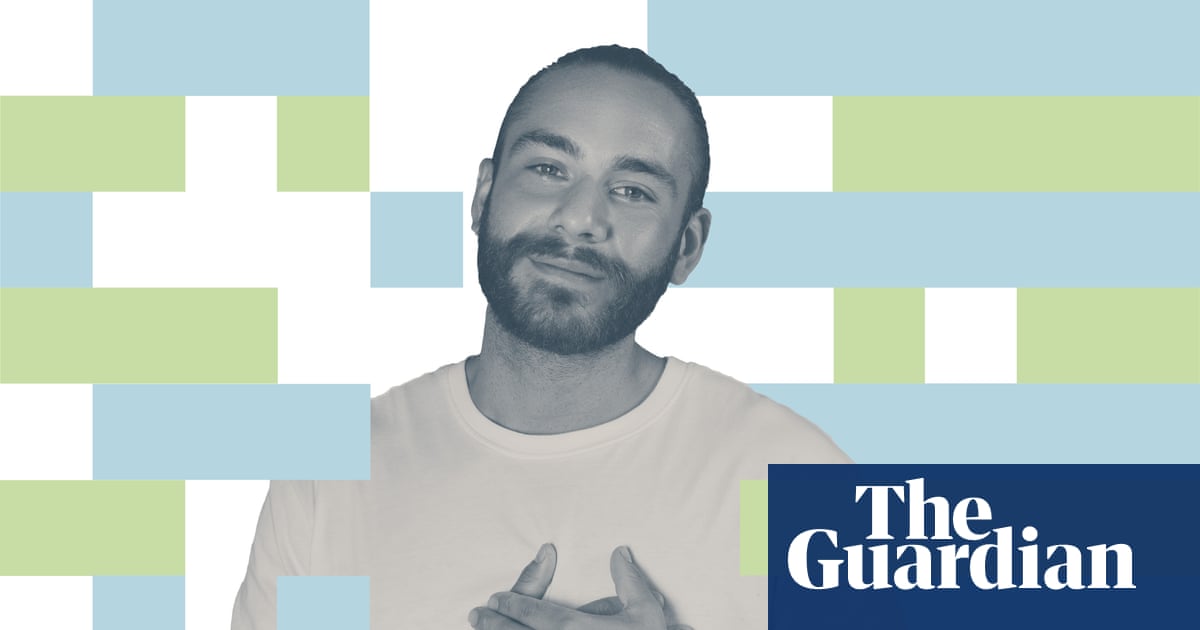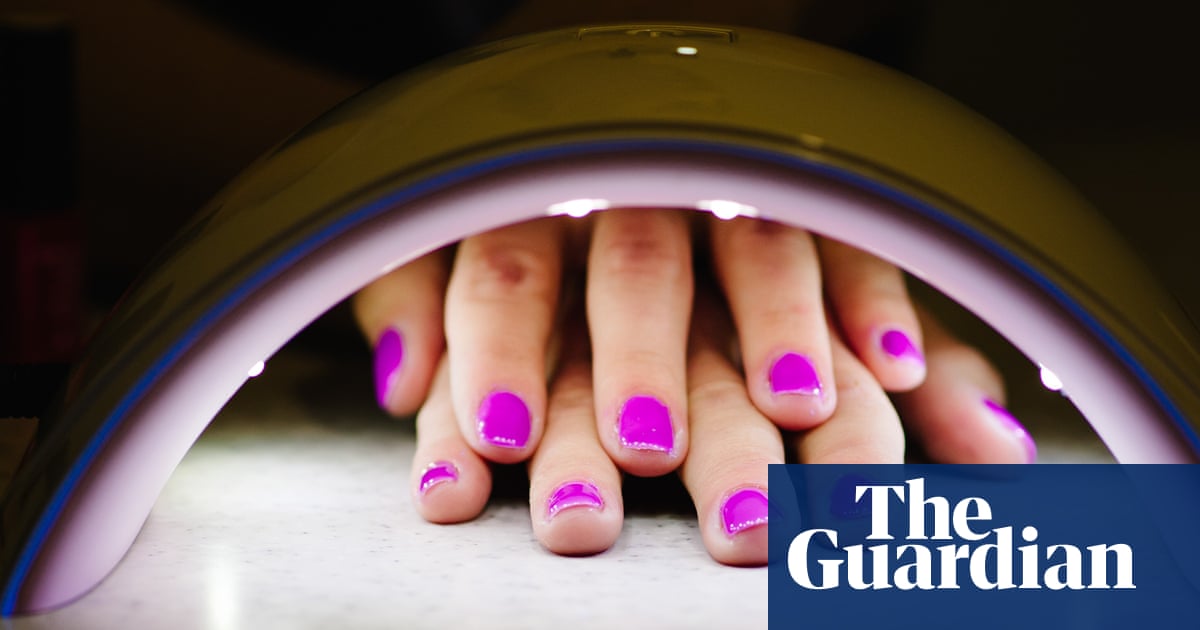The 28-year-old’s platform, Hidden, offers a Tumblr-like sensibility in an industry roiled by slop and lets adult content creators earn without burning out

Stella Barey has an hour for lunch. At 1.30pm, she loads her banged-up Tacoma with her three Belgian malinois and drives to a secret Los Angeles hiking trail. There, she gulps down a tapioca pudding and laces up her sneakers. After checking over her shoulder for foot traffic, she pulls down her brown sweatpants and jiggles her bare ass for the camera. Then come the undies. Her coiffed landing strip hovers above the rocks as a rush of urine floods the trail. Every mile she walks, she films another video: a flash, a moon, a finger up the ass.
When Barey decided in 2020 to pursue porn full-time, she did not imagine that at 28 she would spend more time hunched over a desk – not in the fun way – making flow charts, scheduling Zoom calls, and sending pitch decks. “I’m at my happiest when I’m making a video like putting a strawberry in my butt and pushing it out,” she says. “Now I’m on calls all day and I have tech neck.” Known online as the “Anal Princess”, with large, blinking Shelley Duvall eyes and an American Girl doll pout, she will try anything once – even the title “tech founder”.
Barey is looking to disrupt the porn landscape with Hidden, a site designed to alleviate creator burnout and restore the fun in making and consuming adult content – a place where, unlike OnlyFans, she can post public exposure and piss clips from her daily lunch-break hikes.
Hidden arrives during an uncertain time for porn, especially for gen Z. They are skeptical of it, raised on it and increasingly behind the camera themselves. The platform reflects the DIY sensibility that Barey’s generation grew up with, and its mission speaks to their conflicted relationship with big tech, sex work and making a living online. “At the end of the day, Hidden is more than porn,” Barey says. “It’s a political statement” – and one of the only sex worker-founded sex-tech companies hosting adult content today.
Born in San Juan and raised by a gynaecologist mother, Barey cannot remember a time when she was not insatiably curious about her body. At NYU, she invented her own major – ethical healthcare systems and policy – then finished med school prerequisites for gynaecology at University of California, Los Angeles, where she gravitated to the city’s X-rated underbelly: sex parties, industry mixers, late-night friendships with porn girls. Trapped in her apartment during the first wave of Covid, grinding through schoolwork, she started experimenting with anal sex with her then boyfriend – and sharing her sexploits via dirty story times on TikTok. “This is when TikTok still felt like this hidden little piece of the internet,” she recalls.
Her third video went viral. Men in the comments wanted her OnlyFans. Women wanted more story times. By 2021, Barey had given them both. OnlyFans bikini shots and nude selfies pulled in more than $40,000 a month – enough to make medical school look optional. She dropped out, figuring the white coat would wait for her. On TikTok, she became the horny professor to a cult following of gen Z women, quoting Michel Foucault, Sigmund Freud and Marquis de Sade as she spoke about the color of her vagina, STD checks, treating BV and inserting a menstrual sponge – and the delights of anal sex.
“I was making the sacrifice of potentially ruining my reputation to speak about sexual health and sexual topics, things 99% of the girls my age are also thinking about, in a non-stigmatized way,” Barey says. (Having a gynaecologist mom on speed dial helped.) By 2022, she had hit 750,000 TikTok followers and a $285,000 month on OnlyFans.
It didn’t last. Four years prior, in 2018, federal law made websites legally liable for hosting material linked to sex trafficking. Spooked by the law as well as mounting pressure from banks, advertisers and religious lobbying groups, Instagram and TikTok began issuing “community violations” for even the hint of sexual content. The word obscenity, long the legal standard for what counts as “too sexual”, remained deliberately undefined, giving them carte blanche to remove anything that made them nervous. Adult creators were shadowbanned, deleted and demonetized without warning. But they could not afford to leave the mainstream platforms altogether – that’s where they advertised their content and built fanbases.

To survive, they developed their own internet survival codes, resorting to “algospeak” to circumvent obscenity guidances (“corn” for porn, “seggs” for sex, “accountant” for sex worker), VPNs and burner accounts to evade detection, and private Discords to swap intel. “We became outlaws,” Barey says. “You have no clue what is allowed or not allowed until you get hit with a violation. It’s all word of mouth.”
By the end of 2022, Barey had gone through 22 TikTok accounts, many with more than 600,000 followers, buying burner phones to start from scratch each time she got booted from the platform.
Severely limited by mainstream sites, sex workers sought out new havens for posting adult content, the most popular of which is OnlyFans. Whereas Pornhub and its peers monetize traffic through ads and streaming, OnlyFans monetizes relationships, letting creators sell directly to fans. By 2024, more than 4.6 million creators were pulling in $7.2bn from subscribers. But OnlyFans comes with its own set of problems. The platform is notorious for lacking creator-friendly tools. Unlike Instagram or TikTok, there is no “explore” page or discovery feed; the burden of finding an audience falls entirely on the performer, which means relentless self-promotion on the very sites that are so hostile to them. “People don’t realize that most of these girls don’t want to be doing social media – they just want to make porn,” Barey says.
Once fans do make it to a creator’s page, monthly subscriptions account for only a fraction of potential earnings. The real money comes from time-consuming manual engagement, such as selling custom videos, sexts and one-to-one messaging. At one point, 70% of Barey’s income came from these direct messages. “You can’t be spending your entire day making content, promoting it on socials, and also be on your account selling to fans 24/7,” she says. “It’s unsustainable.”
The idea for Hidden began in 2023, when a high school friend and Wharton business school grad approached Barey about co-founding a porn site. Barey set the terms: a platform designed by and for sex workers, built to promote passive income in an industry where constant performance is often the price of survival. The platform launched on 12 April with a sleek black interface and artful branding. Focused on amateur content, it recalls the Tumblr-era cam girl aesthetic – a period many creators look back on with fondness. (“Hidden” is a reference to the phone folder in which normies keep their nudes.)
After clicking “18+”, users land on a TikTok-style “For You” page that serves clips tailored to their taste. Scrolling through videos and photos, one can find anything from a girl-next-door-type smiling in her pyjamas to a performer gyrating on a lubed-up dildo. See someone you like? A quick swipe to that creator’s profile is usually where the first paywall appears: a small fee to unlock their feed, view explicit posts or send a message.
Barey is most excited about the ways Hidden, unlike OnlyFans, helps creators keep earning without constantly filming or messaging. The site’s algorithm promotes old videos as much as new ones, and each profile includes a built-in store where fans can buy clips and pay-per-view posts – content creators have already made, now working for them in the background.
None of Hidden’s features are brand new, Barey admits. The scrolling feed is lifted from RedGifs; the store from ManyVids; and the chargeback protections, popular among creators for making it harder for customers to dispute charges and get refunds, from SextPanther. But they are consolidated on Hidden, which also takes the smallest cut in the industry (18% of creators’ earnings, compared with OnlyFans’ 20%).
For Leila Lewis, 28, a Philadelphia-based creator making over $30,000 a month on OnlyFans, the appeal was immediate. “Everyone is getting sick of the OnlyFans model. We’re exhausted and burnt out,” she says. After a consultation with Barey, she said Hidden felt like a return to the golden days – something that finally made her excited about the work again. “You can’t do fisting or pee content on OnlyFans,” which is the content her fans like best but is prohibited on the more skittish platform, Lewis explains. “That’s why I love Hidden, because they just let you do pretty much anything.”

Barey oversees a 40-person software team, a product designer and six content moderators, and more features are on the way. Barey and her team are building a takedown bot to scan the internet for leaks and stolen content with a single click. She is experimenting with AI tools that would let fans request personalized clips generated from a performer’s likeness (for instance, “me in a red dress on a plane”), while safeguarding ownership of their likeness from sites that are already selling nonconsensual AI versions of them. Barey even wants Hidden to handle its own payments instead of relying on third-party payment processors – an unheard-of move in the adult industry that would cut out the middlemen that drive up fees. (If she could buy a bank outright, she says, creators might one day keep nearly all of what they earn.)
Ultimately, she insists it’s sex workers who will decide what comes next for Hidden. “I have a list of thousands of things, but if I’m hearing from the girls that they really want live streaming, I’m going to put that up at the top.” Meanwhile, her core crew of gen Z assistants – Drew, Chloe and Naomi, who once ran her OnlyFans and now act as her “angels” – weigh in on everything from marketing strategy to her sex tape’s final cut. Years of navigating porn sites and the minefield of social media have given them an instinct for what will resonate.
So far, Hidden has registered over 113,00 users who have spent on average $53 each, and has enrolled more than 2,100 active creators – most of them gen Z women.
At this moment public sentiment toward porn is souring. That’s in part due to the rise of “rage bait” porn, the kind of deliberately provocative content that first launched Barey into viral fame, when her TikTok about sleeping with her father’s fiftysomething best friend broke the internet. Gen Z creators such as Bonnie Blue and Lily Phillips, whose exhibitionist gangbang spectacles were engineered to be detested, thrive in an ecosystem warped by burnout, censorship, algorithmic whiplash, “slop” churn, and audiences with ever-shortening attention spans. For critics, they are proof the industry has lost its grip.
The backlash also mirrors cultural anxieties about sex, gender and power among gen Z. By age 13, most US teens have already encountered pornography, often by accident. Gen Z is the first cohort to grow up with porn not just available but ambient, algorithmically unavoidable.
The American Survey Center’s 2025 report found that nearly two-thirds of men under 25 now support making online pornography harder to access – a sharp increase from previous generations. This shift could be tied to growing discomfort with porn’s ubiquity, as well as a broader conservative turn among young people (as you can see in the “NoFap” and abstinence trends spreading across TikTok). At the same time, feminist critics, gen Z or otherwise, are calling out the damaging effects of some porn, from normalized choking to transactional “porn-script” sex bleeding into dating culture.
Interestingly, survey data shows gen Z reports less sexual activity than earlier generations, suggesting a more cautious cohort. And yet, new Kinsey Institute research finds gen Z to be the most kink-friendly generation on record.
Internet porn historian Noelle Perdue argues that the contradictions themselves are the story. “There is among younger generations this resentment towards the concept of mainstream pornography,” she says, “but they are also genuinely curious about their sexuality.” What gen Z is open to, she adds, is ethically produced porn that matches their sensitivities and desires. Recent Pornhub data also shows a broader cultural shift toward authenticity in porn: searches for “ethical porn” rose 92% in 2024, while “authentic sex” climbed 43%, meaning viewers are increasingly drawn to user-generated and amateur content over scripted, studio productions that can feel unrealistic.
“Ethical porn”, a recent buzzword in the industry, generally refers to erotic content that is transparently and legally produced, fairly paid and filmed with mutual pleasure in mind; feminist porn filmmakers such as Erika Lust are often held up as the gold standard. Hidden is, in that sense, as ethical as a platform can reasonably claim to be: its content is self-filmed by age-verified performers who own their work and keep most of what they earn. However, one can never be entirely sure what is or is not ethical without being in the room where the sex is happening.
Between her time on TikTok and an in-person erotic philosophy reading series she started last February, Barey has drawn in a wide circle of college-aged women. “I know there’s a rise in conservatism amongst gen Z, but I see this generation as the most accepting of porn of any generation yet,” she says. “They’re so supportive of sex work and understanding it as a legitimate job.”
By the time young people have worked out what they want – or do not want – from porn, it might be a moot point. The Heritage Foundation’s Project 2025 went so far as to openly call for pornography to be outlawed and its producers imprisoned, indicating a rightwing thirst for a national ban on the industry. A less existential but more immediate threat are new age-verification laws across the US and UK that require users to upload government IDs or biometric data before accessing porn. Lawmakers frame these bills as child-protection measures, but in practice they penalize the very platforms trying to comply and slash the income of sex workers – especially queer and trans creators already working on razor-thin margins. When Louisiana’s Act 440 went into effect in 2023, Pornhub reported an 80% drop in traffic from the state, while VPN searches spiked. As Perdue notes, minors will always find adult content; what these laws actually do is punish compliant platforms like Hidden, OnlyFans and Pornhub, and funnel users toward sketchier sites rife with pirated or nonconsensual material.
As of now, porn still accounts for more than a third of internet data transfers. Its future could depend on creators finally taking control of the industry they built. “Tech companies have a long history of establishing financial sustainability by hosting explicit content and then suddenly abandoning it,” Perdue says. “It would be amazing to have this pattern disrupted by a company that is truly aligned with sex workers, instead of just seeing adult content as a means to a financial end.”
Three dogs pant out of open windows as Barey’s pickup barrels down the freeway, away from the hiking trail. She will miss the beginning of her 2.30pm call, a meeting with her chief technology officer to review Hidden’s next software update. There is no signal on this stretch, so for a few more minutes she can remain in her favorite role – just another horny girl on the internet with a camera roll filled with nudes.
“Even though porn has been around forever, this version of online sex work is so brand new,” Barey says. In this way, Hidden may be less a product than a provocation – an argument that an industry dismissed as slop can still be reinvented.

 3 weeks ago
21
3 weeks ago
21

















































